七年级英语上册知识点总结
七年级上册英语全部知识点
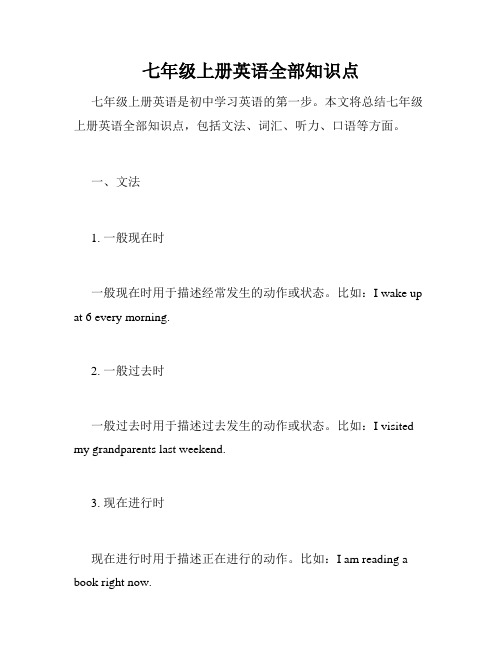
七年级上册英语全部知识点七年级上册英语是初中学习英语的第一步。
本文将总结七年级上册英语全部知识点,包括文法、词汇、听力、口语等方面。
一、文法1. 一般现在时一般现在时用于描述经常发生的动作或状态。
比如:I wake up at 6 every morning.2. 一般过去时一般过去时用于描述过去发生的动作或状态。
比如:I visited my grandparents last weekend.3. 现在进行时现在进行时用于描述正在进行的动作。
比如:I am reading a book right now.4. 一般将来时一般将来时用于描述将来发生的动作或状态。
比如:I will go to the movies tomorrow.5. 祈使句祈使句用于表达命令、请求或建议。
比如:Please give me a glass of water.6. 疑问句疑问句用于询问信息或确认某件事情。
比如:What time is it?二、词汇1. 常见动词动词是英语句子中最常见的词汇,包括go、eat、read、write 等。
2. 常见名词名词用于表示人、地方、事物等,包括book、school、cat、friend等。
3. 常见形容词形容词用于描述名词的特征,比如big、blue、happy等。
4. 常见副词副词用于描述动词、形容词或其他副词的特征,比如quickly、often、quite等。
5. 数词数词用于表示数量,包括one、two、three等,还有表示时间、年龄等的特殊数词。
6. 代词代词用于代替名词,包括I、you、he、she等。
7. 冠词冠词用于修饰名词,包括a、an、the等。
三、听力听力是英语学习中必不可少的一环。
七年级上册英语学生需要能听懂基础的对话,理解简单的英语语音和节奏。
四、口语口语能力是学习英语的重要一环。
七年级上册英语学生需要能够进行基础的英语会话,包括问路、购物、询问天气等。
七年级英语上册知识点总结

七年级英语上册知识点总结七年级英语上册是初中英语学习的开端,它是为学生启蒙英语基础设计的。
在这个阶段,学生需要掌握一些基础知识,比如基本的语法、句型,还有一些简单的词汇和表达方式。
下面是七年级英语上册的知识点总结。
一、基本语法1. 句子成分:主语、谓语、宾语、定语、状语、表语等。
2. 时态:现在时、过去时、将来时。
3. 祈使句:表示命令、请求、建议。
4. 陈述句:表达陈述性意义。
5. 疑问句:表示疑问性意义。
二、基本句型1. 主谓结构:主语+谓语。
2. 主谓宾结构:主语+谓语+宾语。
3. 主语+系动词+表语。
4. There be句型:表示存在,有。
5. 祈使句:表示命令、请求、建议。
三、词汇积累1. 人称代词:I、you、he、she、it、we、they等。
2. 物主代词:my、your、his、her、its、our、their等。
3. 数字:one、two、three、four、five等。
4. 颜色:red、green、blue、yellow等。
5. 食物:bread、rice、noodles、milk、cheese等。
四、日常用语1. 问候语:Hello、Hi、Good morning、Good afternoon、Good evening等。
2. 致谢语:Thank you、Thanks、You're welcome。
3. 道歉语:I'm sorry、Excuse me、Pardon me等。
4. 禁止用语:Don't、No、Not等。
五、交际用语1. 自我介绍:Hello、I'm…、My name is…。
2. 问路:Excuse me、Where is…、How can I go to…。
3. 询问时间:What time is it?、Can you tell me the time?。
4. 约会邀请:Would you like to…?六、阅读理解1. 选择题:根据所给的问题和选项选择最合适的答案。
七年级上册英语知识点归纳
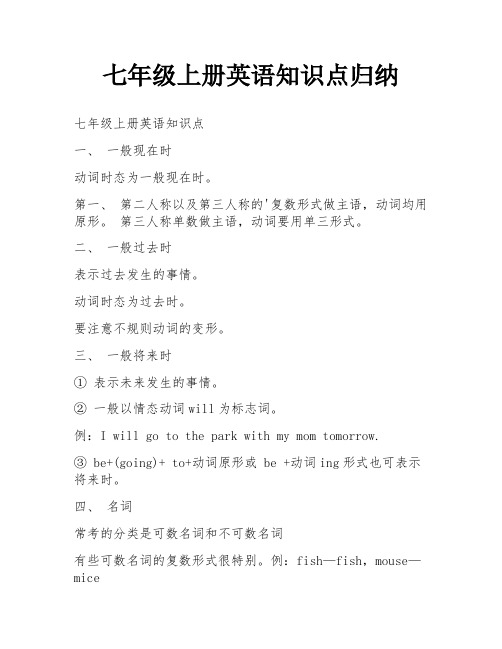
七年级上册英语知识点归纳七年级上册英语知识点一、一般现在时动词时态为一般现在时。
第一、第二人称以及第三人称的'复数形式做主语,动词均用原形。
第三人称单数做主语,动词要用单三形式。
二、一般过去时表示过去发生的事情。
动词时态为过去时。
要注意不规则动词的变形。
三、一般将来时① 表示未来发生的事情。
② 一般以情态动词will为标志词。
例:I will go to the park with my mom tomorrow.③ be+(going)+ to+动词原形或 be +动词ing形式也可表示将来时。
四、名词常考的分类是可数名词和不可数名词有些可数名词的复数形式很特别。
例:fish—fish,mouse—mice五、代词代词主要有:人称代词第一人称:I,we第二人称:you第三人称:he, she, they物主代词① 形容词性物主代词:第一人称:my, our第二人称:your第三人称:his, her, their② 名词性物主代词第一人称:mine, ours第二人称:yours第三人称:his, hers, theirs七年级上册英语知识点总结一、简单句的成分及主谓一致原则最基本构成:主语+谓语+宾语,其中谓语由动词来充当。
主谓一致原则,就是句子的谓语要始终与主语保持数量上的一致性。
当主语是第三人称单数(简称“三单”)时,谓语动词也要相应变成单数形式;当主语非“三单”时,谓语动词就用原形。
实意动词变“三单”的规则如下:1)一般动词在词尾加“-s ”,如:like-likes, tell-tells, play-plays等;2)以字母s, x,ch, sh结尾的动词加“-es ”,如:guess-guesses, teach-teaches, watch-watches等;3)以o结尾的动词一般加“-es ”,如:do-does, go-goes 等;4)以辅音字母加y结尾的动词,先变y为i,再加“-而是”,如:fly-flies, carry-carries等;5)have的三单形式是has。
七年级上册英语知识点

七年级上册英语知识点七年级英语上册知识总结Unit 1:My name's Gina.第一单元我们学习了部分人称代词主格和形容词性物主代词。
具体内容,请看下图趣解语法✍人称代词主格在句中作主语,是整个句子的龙头老大。
注意点:但值得注意的是:I 作主语时,be 动词用am;she/he/it 作主语时,be 动词用is。
英语人称代词用法口诀:人称代词主宾格,作用不同莫用错。
主格动词前做主,动词介词后宾格。
You和it主宾同,其他主宾须分清。
人称代词并列现,尊重他人礼当先。
单数人称二三一,复数人称一二三。
若把错误责任担,第一人称我靠前。
✍形容词性物主代词具有形容词的特性,常放在名词前面作定语,表明该名词所表示的人或物是"谁的"所以我不能单独使用,其后必须跟名词。
比如:my name; your friend……英语物主代词用法口诀:物主代词分两种,形容词性名词性。
形容词性能力差,自己不能来当家。
句子当中作定语,身后定把名词加。
物主代词名词性,相当名词可单用。
句中充当主宾表,身后没有名词影。
两种代词形不同,添个s 形变名。
his,its不用变,my变mine要记清。
话不多说,我们给大家来一些例证吧!✍经典例句1人称代词主格1. I am a girl. 我是一个女孩。
2. He/She is my friend. 他/她是我的朋友。
3. You are very nice. 你非常好。
4. It is a bed. 它是一张床。
2形容词性物主代词5. My name is Mary. 我的名字叫玛丽。
6. Your room is so tidy. 你的房间很整洁。
7. This is his/her pen. 这是他/她的钢笔。
8. That is my dog. Its name is Susan.那是我的狗。
它的名字叫苏珊。
9.He's a student. His mother is a teacher.他是一名学生。
七年级上册英语重要知识点总结归纳
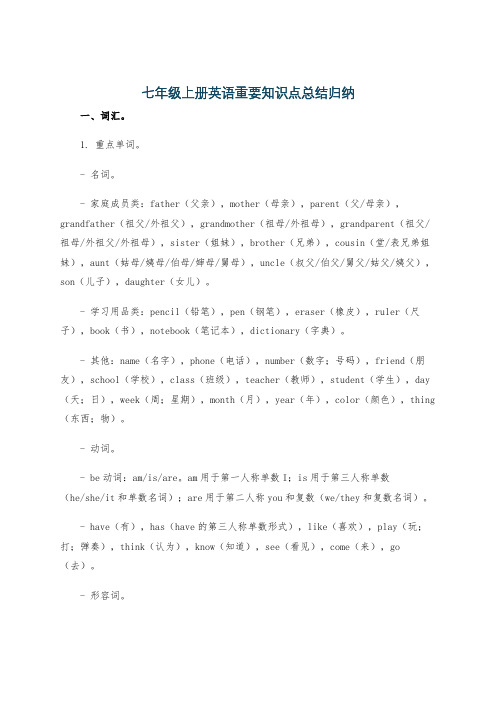
七年级上册英语重要知识点总结归纳一、词汇。
1. 重点单词。
- 名词。
- 家庭成员类:father(父亲),mother(母亲),parent(父/母亲),grandfather(祖父/外祖父),grandmother(祖母/外祖母),grandparent(祖父/祖母/外祖父/外祖母),sister(姐妹),brother(兄弟),cousin(堂/表兄弟姐妹),aunt(姑母/姨母/伯母/婶母/舅母),uncle(叔父/伯父/舅父/姑父/姨父),son(儿子),daughter(女儿)。
- 学习用品类:pencil(铅笔),pen(钢笔),eraser(橡皮),ruler(尺子),book(书),notebook(笔记本),dictionary(字典)。
- 其他:name(名字),phone(电话),number(数字;号码),friend(朋友),school(学校),class(班级),teacher(教师),student(学生),day (天;日),week(周;星期),month(月),year(年),color(颜色),thing (东西;物)。
- 动词。
- be动词:am/is/are。
am用于第一人称单数I;is用于第三人称单数(he/she/it和单数名词);are用于第二人称you和复数(we/they和复数名词)。
- have(有),has(have的第三人称单数形式),like(喜欢),play(玩;打;弹奏),think(认为),know(知道),see(看见),come(来),go (去)。
- 形容词。
- good(好的),nice(美好的;令人愉快的),fine(健康的;美好的),red (红色的),blue(蓝色的),green(绿色的),black(黑色的),white(白色的),yellow(黄色的),big(大的),small(小的),long(长的),short(短的;矮的)。
七年级英语上册总复习知识点考点总结归纳
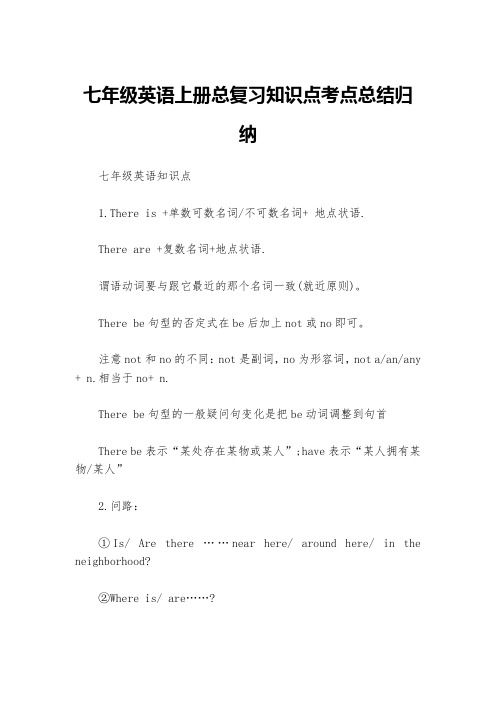
七年级英语上册总复习知识点考点总结归纳七年级英语知识点1.There is +单数可数名词/不可数名词+ 地点状语.There are +复数名词+地点状语.谓语动词要与跟它最近的那个名词一致(就近原则)。
There be句型的否定式在be后加上not或no即可。
注意not和no的不同:not是副词,no为形容词,not a/an/any + n.相当于no+ n.There be句型的一般疑问句变化是把be动词调整到句首There be表示“某处存在某物或某人”;have表示“某人拥有某物/某人”2.问路:①Is/ Are there ……near here/ around here/ in the neighborhood?②Where is/ are……?③How can I get to……?④Could/Can you tell me the way to……⑤Which is the way to……3.Across,cross,through,overAcross是介词,“横过,在对面”表示从物体表面穿过Cross是动词,相当于go/ walk acrossThrough是介词,表示从物体中间或里面穿过 go through the doorOver是介词,“横过,越过”表示从物体上空越过,跨过 fly over4.ask for help/ advice5.in/ on the street6.在某条大街上习惯用介词on on Bridge Street7.across from,next to,between…and…,behind8.in front of在…(外部的)前面→behind在…后面 in the front of在…(内部的)前面9.be in town→be out of town10.be far from11.go/ walk along go straight go up/ down12.turn left/right13.on one’s/ the left14.at the first crossing/ turning15.sometimes 有时(频度副词)sometime(将来)有朝一日,(曾经)某天Some times 几次,几倍 some time 一段时间(前面用介词for) 16.free空闲的 free time自由的 as free as a fish免费的 The best things in life are free.17.enjoy doing18.Time goes quickly.19.表“一些”在肯定句中用some.在疑问句和否定句中用any。
七年级英语语法知识点归纳总结上册

七年级英语语法知识点归纳总结上册一、名词。
1. 名词的分类。
- 专有名词:表示特定的人、地方、组织等,首字母大写,如China(中国),Tom(汤姆)。
- 普通名词:- 可数名词:有单复数形式,如book(书,单数),books(复数)。
- 不可数名词:没有复数形式,如water(水),milk(牛奶)。
2. 可数名词复数的变化规则。
- 一般情况加 -s,如pen - pens,desk - desks。
- 以s, x, ch, sh结尾的加 -es,如bus - buses,box - boxes,watch - watches,brush - brushes。
- 以辅音字母 + y结尾的,变y为i加 -es,如baby - babies。
- 以f或fe结尾的,变f或fe为v加 -es,如knife - knives,leaf - leaves(但也有一些直接加 -s的,如roof - roofs)。
- 不规则变化,如man - men,woman - women,child - children,foot - feet,tooth - teeth。
3. 名词所有格。
- 有生命的名词所有格:- 一般在名词后加's,如Tom's book(汤姆的书)。
- 以s结尾的复数名词,只加',如the students' classroom(学生们的教室)。
- 表示两者共有时,在后一个名词后加's,如Lucy and Lily's mother(露西和莉莉的妈妈);表示各自拥有时,在每个名词后加's,如Lucy's and Lily's bags (露西的包和莉莉的包)。
- 无生命的名词所有格,用“of+名词”结构,如the window of the room(房间的窗户)。
二、代词。
1. 人称代词。
- 主格:I(我),you(你/你们),he(他),she(她),it(它),we(我们),they(他们/她们/它们),在句中作主语,如I like English.(我喜欢英语)。
七年级上册英语重要知识点总结归纳

七年级上册英语重要知识点总结归纳在七年级上学期的英语学习中,我们学习了许多重要的知识点。
通过对这些知识点的总结归纳,我们可以更好地巩固所学内容,并帮助我们更好地掌握英语。
一、基本语法知识点1. 一般现在时:表示经常性动作或普遍真理。
例如:I go to school every day.2. 一般过去时:表示过去某个时间发生的动作。
例如:I watched a movie last night.3. 现在进行时:表示目前正在进行的动作。
例如:She is studying for the exam.4. 句子结构:英语句子的基本结构为“主语 + 谓语 + 宾语”。
有时还需要加上状语等。
例如:Tom is reading a book at home.5. 情态动词:表示能力、可能性、必要性等情态。
例如:He can swim very well.二、词汇知识点1. 动词:表示动作或状态的词汇。
例如:run, play, sleep。
2. 名词:表示人、事物或抽象概念的词汇。
例如:book, apple, happiness。
3. 形容词和副词:形容词用来修饰名词,副词用来修饰动词、形容词或其他副词。
例如:beautiful, quickly。
4. 介词:用来表示方位、时间、原因等。
例如:in, on, at。
5. 数词:表示数量的词汇。
例如:one, two, three。
三、常用句型和表达方式1. 问候和介绍:常用的问候方式包括:“How are you?”, “Nice to meet you.”等。
在介绍他人时,可以使用句型:“This is...”加上对方的名字。
2. 时间表达:常用的时间表达方式有“on Monday”, “in the morning”等。
3. 疑问句和否定句:疑问句通常以助动词开头,例如:“Are you happy?” 否定句通常在动词前面加上“not”,例如:“I do not know.”4. 表达喜好:可以使用句型“I like...”或“I love...”来表示自己的喜好。
7年级上册英语知识点总结归纳

7年级上册英语知识点总结归纳
七年级上册英语知识点总结归纳
一、一般现在时
定义:表示经常发生的动作或存在的状态。
结构:主语+谓语(动词原形)+宾语(名词/代词)。
常用时间状语:always、usually、often、sometimes、every day、on Sundays等。
二、现在进行时
定义:表示现在正在进行的动作。
结构:主语+be动词(am/is/are)+动词ing。
常用时间状语:now、right now等。
三、一般过去时
定义:表示过去某个时间发生的动作或存在的状态。
结构:主语+谓语(动词过去式)+宾语(名词/代词)。
常用时间状语:yesterday、last night、two days ago等。
四、一般将来时
定义:表示将来某个时间发生的动作或存在的状态。
结构:主语+will+动词原形+宾语(名词/代词)。
常用时间状语:tomorrow、next week、in the future等。
五、介词的用法
表示时间的介词:at+具体时间点;in+年/月/季节;on+星期几/日期;for+时间段;since+时间点等。
表示地点的介词:in+大地点;at+小地点;in+地点+of+国家/城市等。
六、祈使句的用法
定义:表示请求、命令或建议的句子。
结构:动词原形+宾语+其他成分。
常用句型:Please+动词原形+宾语+其他成分;Let’s+动词原形+宾语+其他成分;动词原形+宾语+其他成分。
七年级上册英语知识点归纳总结
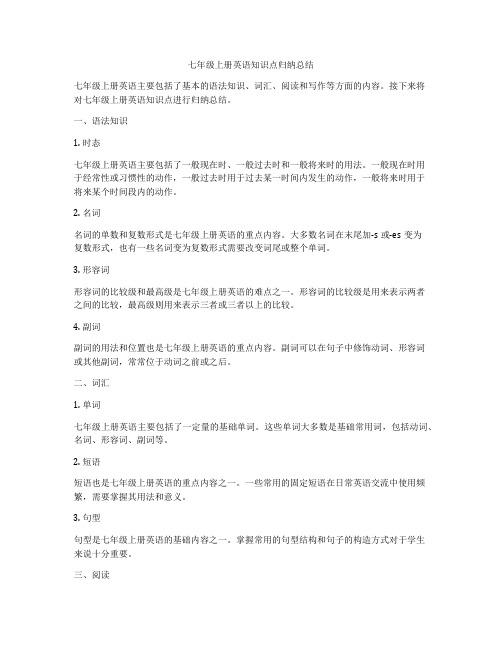
七年级上册英语知识点归纳总结七年级上册英语主要包括了基本的语法知识、词汇、阅读和写作等方面的内容。
接下来将对七年级上册英语知识点进行归纳总结。
一、语法知识1. 时态七年级上册英语主要包括了一般现在时、一般过去时和一般将来时的用法。
一般现在时用于经常性或习惯性的动作,一般过去时用于过去某一时间内发生的动作,一般将来时用于将来某个时间段内的动作。
2. 名词名词的单数和复数形式是七年级上册英语的重点内容。
大多数名词在末尾加-s或-es变为复数形式,也有一些名词变为复数形式需要改变词尾或整个单词。
3. 形容词形容词的比较级和最高级是七年级上册英语的难点之一。
形容词的比较级是用来表示两者之间的比较,最高级则用来表示三者或三者以上的比较。
4. 副词副词的用法和位置也是七年级上册英语的重点内容。
副词可以在句子中修饰动词、形容词或其他副词,常常位于动词之前或之后。
二、词汇1. 单词七年级上册英语主要包括了一定量的基础单词。
这些单词大多数是基础常用词,包括动词、名词、形容词、副词等。
2. 短语短语也是七年级上册英语的重点内容之一。
一些常用的固定短语在日常英语交流中使用频繁,需要掌握其用法和意义。
3. 句型句型是七年级上册英语的基础内容之一。
掌握常用的句型结构和句子的构造方式对于学生来说十分重要。
三、阅读1. 阅读理解阅读理解是七年级上册英语的基础内容之一。
阅读理解包括对文中具体信息的理解和推理能力的培养。
2. 阅读技巧阅读技巧包括了提取信息、推理判断、综合运用等方面的内容。
通过掌握好阅读技巧,有助于提高学生的阅读能力。
四、写作1. 句子写作中的句子包括了简单句和复合句等多种句型。
学生需要掌握不同类型的句子结构,以便更好地表达自己的意思。
2. 段落写作中的段落包括了开头、中间和结尾等构成要素。
学生需要学会如何组织和安排段落,使得文章的结构清晰。
以上是七年级上册英语知识点的归纳总结,希望对学生在学习英语的过程中有所帮助。
七年级上册英语知识点归纳总结

七年级上册英语知识点归纳总结一、词汇与短语1. 基本词汇- 问候语:hello, hi, good morning/afternoon/evening- 常见颜色:red, blue, green, yellow, black, white, pink- 数字:one to ten, first to twelfth (for months and dates) - 常见动物:cat, dog, bird, fish, elephant, tiger- 家庭成员:mother, father, sister, brother, grandmother, grandfather2. 学校相关词汇- 学科:English, math, science, history, art, P.E. (physical education)- 学校设施:classroom, library, gym, cafeteria, office- 学习用品:book, pen, pencil, eraser, ruler, backpack3. 日常活动与习惯- 活动:play, read, write, listen, watch, eat, drink- 习惯:brush teeth, wash face, take a shower, go to bed4. 常见食物与饮料- 食物:apple, banana, orange, bread, rice, chicken, fish- 饮料:water, milk, juice, tea, coffee5. 常见形容词- 大小:big, small- 形状:round, square, long, short- 颜色相关:red, blue, green, yellow, etc.- 情感:happy, sad, angry, excited二、语法要点1. 时态- 一般现在时:表示经常发生的动作或状态,使用动词原形。
七年级上册英语知识点归纳总结
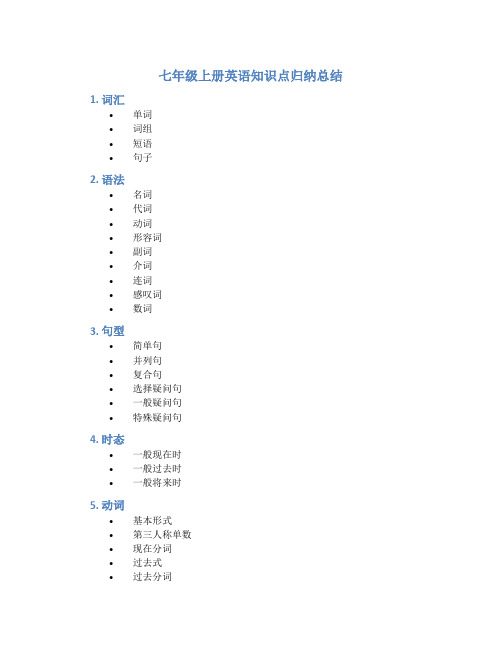
七年级上册英语知识点归纳总结1. 词汇•单词•词组•短语•句子2. 语法•名词•代词•动词•形容词•副词•介词•连词•感叹词•数词3. 句型•简单句•并列句•复合句•选择疑问句•一般疑问句•特殊疑问句4. 时态•一般现在时•一般过去时•一般将来时5. 动词•基本形式•第三人称单数•现在分词•过去式•过去分词6. 语法技巧•句子的主谓一致•名词的单复数•形容词的比较级和最高级•副词的比较级和最高级•介词的基本用法•语序•语气7. 基本能力•听力能力 -口语表达能力•书写能力•阅读能力8. 日常用语•问候语•道别语•感谢语•询问与回答•询问与回答地点•询问与回答时间•询问与回答方向•询问与回答天气•询问与回答年龄•询问与回答身高•询问与回答体重9. 形容词与副词•形容词的用法•形容词的比较级和最高级•副词的用法•副词的比较级和最高级10. 现在进行时•构成与用法•否定句与疑问句•常用的现在进行时词组11. 一般将来时•构成与用法•否定句与疑问句•常用的一般将来时词组12. 句子类型•陈述句•祈使句•疑问句•感叹句13. 数词•基数词•序数词•数词的用法14. 交际用语•问候与回答•自我介绍与回答•询问与回答个人信息15. 学习技巧•听力训练•阅读技巧•口语训练•语法练习•写作练习以上是七年级上册英语的知识点归纳总结,掌握这些知识点能够帮助学生更好地学习和应用英语。
在学习过程中,要注重实际应用和不断练习,提高自己的听说读写能力,培养英语思维,提高学习效果。
希望同学们能够认真学习,不断提高自己的英语水平。
七年级英语上册知识点总结
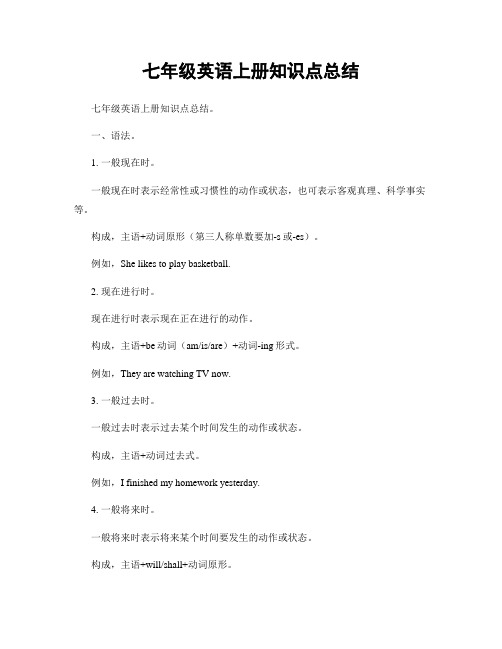
七年级英语上册知识点总结七年级英语上册知识点总结。
一、语法。
1. 一般现在时。
一般现在时表示经常性或习惯性的动作或状态,也可表示客观真理、科学事实等。
构成,主语+动词原形(第三人称单数要加-s或-es)。
例如,She likes to play basketball.2. 现在进行时。
现在进行时表示现在正在进行的动作。
构成,主语+be动词(am/is/are)+动词-ing形式。
例如,They are watching TV now.3. 一般过去时。
一般过去时表示过去某个时间发生的动作或状态。
构成,主语+动词过去式。
例如,I finished my homework yesterday.4. 一般将来时。
一般将来时表示将来某个时间要发生的动作或状态。
构成,主语+will/shall+动词原形。
例如,We will go to the park tomorrow.二、词汇。
1. 数词。
基数词表示数量,序数词表示顺序。
例如,three apples, the first day。
2. 形容词。
形容词用来修饰名词,表示人或事物的特征。
例如,a beautiful girl, an interesting book。
3. 动词。
动词表示行为或状态。
例如,play, read, run。
4. 代词。
代词用来代替名词,分为人称代词、物主代词、反身代词等。
例如,he, she, my, your, myself。
三、阅读。
1. 阅读理解。
阅读理解是考察学生对文章内容的理解能力,包括主旨大意、细节理解、推理判断等。
例如,阅读一篇关于动物的短文,回答相关问题。
2. 阅读表达。
阅读表达是考察学生根据所读文章进行表达的能力,包括书面表达和口头表达。
例如,根据所给提示,写一篇关于假期生活的短文。
四、写作。
1. 书面表达。
书面表达是考察学生的书面表达能力,包括句子结构、语法、词汇、逻辑性等方面。
例如,写一封邀请信,邀请朋友参加生日聚会。
初中英语七年级上册知识点总结(最新最全)
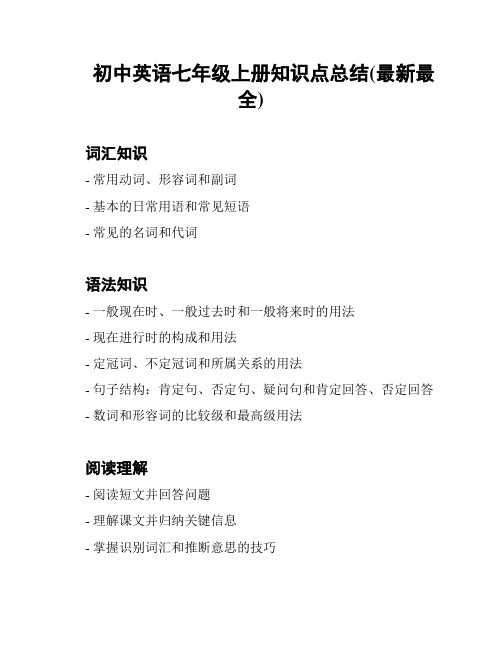
初中英语七年级上册知识点总结(最新最
全)
词汇知识
- 常用动词、形容词和副词
- 基本的日常用语和常见短语
- 常见的名词和代词
语法知识
- 一般现在时、一般过去时和一般将来时的用法
- 现在进行时的构成和用法
- 定冠词、不定冠词和所属关系的用法
- 句子结构:肯定句、否定句、疑问句和肯定回答、否定回答- 数词和形容词的比较级和最高级用法
阅读理解
- 阅读短文并回答问题
- 理解课文并归纳关键信息
- 掌握识别词汇和推断意思的技巧
写作技巧
- 写作简单句和复合句
- 描述人、地点和事物
- 写作日记、邀请函和书信的格式和写法
听力理解
- 听取并理解基本的日常对话和问答
- 听写基本的单词和短语
- 听取并理解短文和问题
口语表达
- 进行简单的自我介绍
- 表达自己的喜好和日常活动
- 提问和回答问题
这份文档是初中英语七年级上册知识点的总结,包括了词汇知识、语法知识、阅读理解、写作技巧、听力理解和口语表达等方面的内容。
希望能够帮助同学们更好地掌握和应用英语知识。
如需更详细的内容,请参考教材或向老师寻求帮助。
请注意,此文档为简要总结,具体内容请参考教材或向老师寻求帮助。
七年级英语上册知识点归纳总结

七年级英语上册知识点归纳总结一、语法1. 时态1) 一般现在时:表示经常性或习惯性的动作或状态,如“They often play football together.”2) 现在进行时:表示现阶段正在进行的动作,如“She is readinga book.”3) 一般过去时:表示过去某一点的动作或状态,如“He watched TV last night.”4) 过去进行时:表示过去某一时刻正在进行的动作,如“I was studying when he called me.”5) 一般将来时:表示将来的动作或情况,如“I will go to the zoo next week.”2. 名词1) 可数名词和不可数名词:可数名词可以数的,不可数名词不能数的,如“apple”和“milk”分别为可数名词和不可数名词。
2) 名词所有格:名词所有格表示所属关系,如“The boy’s bike”表示男孩的自行车。
3. 代词1) 主格和宾格代词:主语和宾语的代词形式,如“I”和“me”分别为主格和宾格代词。
2) 形容词性物主代词:表示所属关系的代词,如“my”和“his”。
4. 动词1) 动词的几种形式:包括原形、过去式、过去分词和现在分词,如“go”、“went”、“gone”和“going”为go的四种形式。
5. 数词1) 基数词和序数词:基数词表示数量,如“one”和“two”;序数词表示顺序,如“first”和“second”。
二、词汇1. 常用词汇1) 人称代词:包括“I”、“you”、“he”、“she”、“it”、“we”和“they”等。
2) 动词词组:包括“go to”、“have lunch”、“watch TV”等常用动词短语。
3) 数词:包括基数词和序数词,如“one”、“two”和“first”、“second”等。
2. 学科词汇1) 数学词汇:包括“add”、“subtract”、“multiply”和“divide”等数学相关词汇。
人教版七年级英语上册初中知识点归纳总结
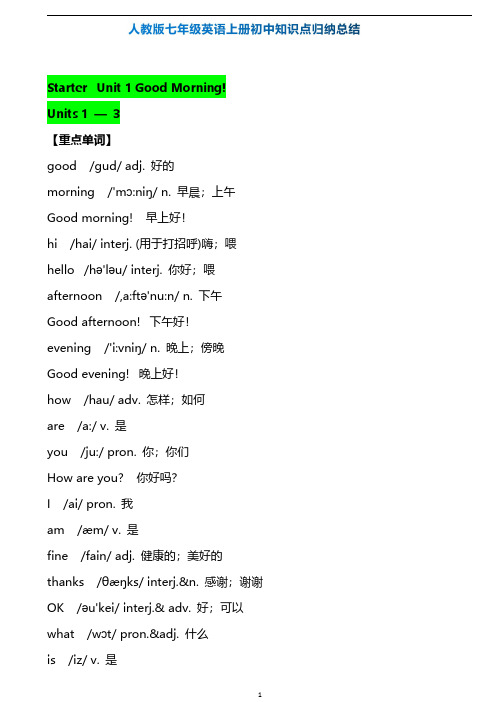
Starter Unit1Good Morning! Units1—3【重点单词】good/gud/adj.好的morning/'mɔ:niŋ/n.早晨;上午Good morning!早上好!hi/hai/interj.(用于打招呼)嗨;喂hello/hə'ləu/interj.你好;喂afternoon/,a:ftə'nu:n/n.下午Good afternoon!下午好!evening/'i:vniŋ/n.晚上;傍晚Good evening!晚上好!how/hau/adv.怎样;如何are/a:/v.是you/ju:/pron.你;你们How are you?你好吗?I/ai/pron.我am/æm/v.是fine/fain/adj.健康的;美好的thanks/θæŋks/interj.&n.感谢;谢谢OK/əu'kei/interj.&adv.好;可以what/wɔt/pron.&adj.什么is/iz/v.是this/ðis/pron.这;这个in/in/prep.(表示使用语言、材料等)用;以English/'iŋgliʃ/n.英语adj.英格兰的;英语的in English用英语map/mæp/n.地图cup/kʌp/n.杯子ruler/'ru:lə/n.尺;直尺pen/pen/n.笔;钢笔orange/'ɔrindʒ/n.橙子jacket/'dʒækit/n.夹克衫;短上衣key/ki:/n.钥匙quilt/kwilt/n.被子;床罩it/it/pron.它a/ə/art.(用于单数可数名词前)一(人、事、物) that/ðæt/pron.那;那个spell/spel/v.用字母拼;拼写please/pli:z/interj.(用于客气地请求或吩咐)请color/'kʌlə/n.(=colour)颜色red/red/adj.&n.红色(的)yellow/'jeləu/adj.&n.黄色(的)green/gri:n/adj.&n.绿色(的)blue/blu:/adj.&n.蓝色(的)black/blæk/adj.&n.黑色(的)white/wait/adj.&n.白色(的)purple/'pə:pl/adj.&n.紫色(的)brown/braun/adj.&n.棕色(的);褐色(的)the/ði;ðə/art.指已提到或易领会到的人或事now/nau/adv.现在;目前see/si:/v.理解;明白can/kæn/modal v.能;会say/sei/v.说;讲my/mai/pron.我的知识点:1.短语归纳:good morning早上好good afternoon下午好good evening晚上好name list名单an English name英文名字2.必背典句:(1)Good morning,Alice!早上好,艾丽斯!(2)Good afternoon!下午好!(3)Hi,Bob!你好,鲍勃!(4)Hello,Frank!你好,弗兰克!(5)Good evening晚上好!(6)—How are you?你好吗?—I’m fine,thanks.How are you?我很好,谢谢。
新人教版七年级英语上册知识点总结

新人教版七年级英语上册知识点总结一、Starter Units 1 - 3知识点。
1. 字母。
- 26个英文字母的大小写书写形式、占格及读音。
大写字母一般占上两格,如A、B等;小写字母占格情况不同,如a、c占中间一格,b、d占上两格,g、p、q占下两格等。
- 字母的分类:元音字母(a, e, i, o, u)和辅音字母(除元音字母外的其他字母)。
2. 单词。
- 常见的问候语单词:hello(你好),hi(嗨),good(好的),morning(早晨),afternoon(下午),evening(晚上)。
- 颜色类单词:red(红色),blue(蓝色),green(绿色),black(黑色),white(白色),yellow(黄色)等。
- 文具类单词:pen(钢笔),pencil(铅笔),ruler(尺子),eraser(橡皮),crayon(蜡笔)等。
3. 句型。
- 问候语:- - Hello, Frank! - Hello, Eric!- - Good morning! - Good morning!- - How are you? - I'm fine, thank you. And you? - I'm OK.- 介绍颜色:- - What color is it? - It's red.- 询问物品:- - What's this in English? - It's a pen.二、Unit 1 My name's Gina.知识点。
1. 单词。
- name(名字),nice(美好的),to(不定式符号,无实义),meet(遇见),too(也),your(你的;你们的),his(他的),her(她的)。
- 名字相关:first name(名),last name(姓),例如:Gina Green中,Gina是first name,Green是last name。
七年级上册英语全部知识点总结

七年级上册英语全部知识点总结一、词汇1. 问候语:hello, hi2. 人名:Alice, Bob, Cindy, Dale, Eric, Frank, Grace, Helen3. 指示代词:this, that4. 人称代词:I, you, he, she, it5. 形容词性物主代词:my, your, his, her6. 名词:pen, pencil, book, eraser, ruler, schoolbag, dictionary, teacher, student, classroom7. 动词:be (am, is, are)8. 数词:zero, one, two, three, four, five, six, seven, eight, nine9. 颜色:red, yellow, green, blue, black, white, purple, brown10. 家庭成员:mother, father, parent, sister, brother, grandmother, grandfather, grandparent, family二、语法1. 一般现在时- 定义:表示经常发生的动作或存在的状态。
- 构成:主语 + be (am/is/are) + 其他;主语 + 实义动词 + 其他- 例句:I am a student. He plays basketball every day.2. 人称代词和物主代词- 人称代词主格:I, you, he, she, it, we, they- 人称代词宾格:me, you, him, her, it, us, them- 形容词性物主代词:my, your, his, her, its, our, their- 例句:She is my sister. This is his book.3. 指示代词 this 和 that- this 指较近的人或物,that 指较远的人或物- 复数形式:these(这些),those(那些)- 例句:This is a pen. That is a ruler.4. 名词的单复数- 一般情况在词尾加 -s,如:book - books- 以 s, x, ch, sh 结尾的名词加 -es,如:box - boxes- 以辅音字母 + y 结尾的名词,变 y 为 i 再加 -es,如:family - families- 不规则变化:man - men, woman - women, child - children5. 介词 in, on, under- in 表示“在……里面”,如:in the bag- on 表示“在……上面”,如:on the desk- under 表示“在……下面”,如:under the chair6. 特殊疑问句- 以特殊疑问词开头的疑问句,常见的特殊疑问词有:what(什么), who (谁), where(哪里), how(怎样)等- 例句:What's your name? Where is my pen?三、句型1. 打招呼:- Hello! / Hi!- Good morning/afternoon/evening!- How are you? I'm fine, thanks.2. 介绍自己和他人:- I'm...- This is...3. 询问物品:- What's this/that in English? It's a/an...4. 确认物品所属:- Is this/that your...? Yes, it is. / No, it isn't.5. 询问颜色:- What color is it? It's...6. 表达拥有:- I have...- You have...四、语音1. 元音字母 a, e, i, o, u 的发音规则2. 常见的元音字母组合的发音,如:ai, ea, ee 等3. 辅音字母的发音4. 常见的辅音字母组合的发音,如:ch, sh, th 等五、写作1. 能够简单介绍自己和家人2. 描述物品的位置和颜色3. 用英语写简单的问候语和对话。
人教版英语七年级上册知识点总结
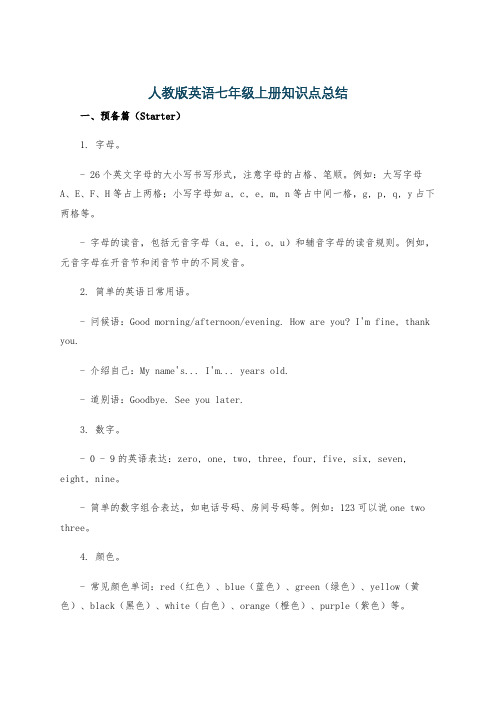
人教版英语七年级上册知识点总结一、预备篇(Starter)1. 字母。
- 26个英文字母的大小写书写形式,注意字母的占格、笔顺。
例如:大写字母A、E、F、H等占上两格;小写字母如a, c, e, m, n等占中间一格,g, p, q, y占下两格等。
- 字母的读音,包括元音字母(a, e, i, o, u)和辅音字母的读音规则。
例如,元音字母在开音节和闭音节中的不同发音。
2. 简单的英语日常用语。
- 问候语:Good morning/afternoon/evening. How are you? I'm fine, thank you.- 介绍自己:My name's... I'm... years old.- 道别语:Goodbye. See you later.3. 数字。
- 0 - 9的英语表达:zero, one, two, three, four, five, six, seven, eight, nine。
- 简单的数字组合表达,如电话号码、房间号码等。
例如:123可以说one two three。
4. 颜色。
- 常见颜色单词:red(红色)、blue(蓝色)、green(绿色)、yellow(黄色)、black(黑色)、white(白色)、orange(橙色)、purple(紫色)等。
二、正式篇(Unit 1 - Unit 9)1. Unit 1 My name's Gina.- 重点单词。
- name(名字)、nice(美好的)、to(不定式符号,无实义)、meet(遇见)、too(也)、your(你的,你们的)、his(他的)、her(她的)。
- 重点句型。
- What's your name? My name's...- Nice to meet you. Nice to meet you, too.- Is he Jack? Yes, he is./No, he isn't.- Are you Helen? Yes, I am./No, I'm not.- 语法点。
新人教版七年级上册英语语法、短语和知识点总结

新人教版七年级上册英语语法、短语和知
识点总结
一、语法部分
1. 一般现在时
- 用于表达经常性、惯性的动作或状态。
- 谓语动词用基本形式。
2. 一般过去时
- 用于表达过去发生的动作或状态。
- 谓语动词用过去式。
3. 现在进行时
- 用于表达现在正在进行的动作。
- 谓语动词由“be”动词的相应形式与现在分词构成。
4. 动词不定式
- 作为名词、形容词或副词的补足语。
- 用于表达目的、原因、结果等。
二、短语部分
1. in front of
- 在...前面
2. on the right/left
- 在右边/左边
3. at the back of
- 在...后面
4. go straight
- 直走
三、知识点部分
1. 单复数
- 名词的复数形式变化规则。
2. 冠词
- a/an 用于泛指单数可数名词前。
- the 用于特指名词前。
3. 人称代词
- I, you, he, she, it, we, they。
4. 并列连词
- and, but, or 用于连接并列的词、短语或句子。
四、总结
本文档总结了新人教版七年级上册英语课程中的语法、短语和
知识点。
内容包括一般现在时、一般过去时、现在进行时等语法部分,以及一些常用短语和知识点。
希望对研究者有所帮助。
以上是对新人教版七年级上册英语语法、短语和知识点的总结。
注意:
本文档中的内容仅供参考。
- 1、下载文档前请自行甄别文档内容的完整性,平台不提供额外的编辑、内容补充、找答案等附加服务。
- 2、"仅部分预览"的文档,不可在线预览部分如存在完整性等问题,可反馈申请退款(可完整预览的文档不适用该条件!)。
- 3、如文档侵犯您的权益,请联系客服反馈,我们会尽快为您处理(人工客服工作时间:9:00-18:30)。
七年级上册知识点总结Starter Unit 1 Good morning!重点单词:Good, morning, hi, hello, afternoon, evening, how, are, you, I, am, fine, thanks, Ok, thank重点句型和语法:一、见面问候语1 -Good morning! -Good morning!-Good afternoon! -Good afternoon!-Good evening! -Good evening!-Good night! -Good night! 一天中的问候语2 -How are you ? 好友重逢-I’m fine, thanks. / Fine, thank you. /I’m OK, thank you very much. And you?-I’m fine, too. Thanks.3 -How do you do? 初次见面- How do you do?4 -Hello/Hi!-Hello/Hi! Hello较正式但一般不对长辈说二、Be动词的用法Be动词的一般现在时有三种:1 I与第一人称(I)连用;is与第三人称(他he,她she,它it)和其他单数名词连用;are与人称复数(第一人称we,第二人称you,第三人称they)和复数名词连用。
即:我(I)用am, 你(you)用are, is跟着他(he)她(she)它(it);单数名词用is复数名词全用are三、大写字母的用法:1 句子开头要大写(首字母)How are you?2 文章标题要大写(虚词除外);Good morning!3 节日、月份、星期几(专有名词);New Year’s Day, May, Monday4 报纸、杂志和书籍;China Daily, Jane5 职业、头衔和称谓;Doctor Wang, President Wen, Uncle Wang6 I 和OK要大写;7 缩略词语要大写。
MBA, CCTVStarter Unit 2 What’s this in English?重点单词和短语:What, is, this, in, English, map, cup, ruler, pen, orange, jacket, key, quilt, it, a, that, spell, please, in English, an orange, a key, a ruler, a map, a quilt.重点句型和语法:一、what引导的特殊疑问句1 -What’s this in English?-It’s a map/ruler/pen/jacket/key/quilt/an orange.-How do you spell it? /Spell it, please. Can you spell it?-M-A-P/……What colour is it?/ What’s your name?……二、不定冠词a/an的用法:1 表示数量“一”(微弱的);a book2 不具体说的某人或某物;a Mr Wang3 泛指某一类人或物;a cat4 某一类人或物中的任何一个; There is an elephant in the zoo.5 首次提到的人或物; This is a ky.6 用于抽象名词前,使抽象名词具体化; It’s a pleasure to talk with you.7 某些固定搭配中:have a look, take a walk, have a good time.a用于以辅音因素开头的单数可数名词之前,an用于以元音因素开头的单数可数名词之前。
三、this,that指示代词的用法This: “这个,这”指近处或距离说话人较近的人或物。
That: “哪个,那”指远处或距离说话人较远的人或物。
Starter Unit 3 What colour is it?重点单词:Colour, red, yellow, green, blue, black, white, purple, brown, the, now, see, can, say, my, what colour重点句型和语法:一、重点句型:1 -Good morning!-Good morning!-What’s this in English?/What’s this? /What’s that?-It’s a map/ruler/pen/jacket/key/quilt/an orange.-How do you spell it? /Spell it, please. Can you spell it?-M-A-P/……-What colour is it?-It’s red/blue/yellow……2 -What colour are the rooms?-They are……3 The ruler is blue.二、定冠词the的用法:The表示特指的人、物或群体,作用相当于this, that, these, those.特指说话双方都知道的人、物或上文已提到的人、物。
1 表示某个(些)特定的人或事物; Give me the book.2 特指说话双方都知道的人或事物; Where is the book?3 指上文提到过的人或事物;This is a pen, the pen is black.4 用在世界上独一无二的事物前;the sun, the earth, the moon, the world5 和某些形容词连用,表示一类人;the old, the young, the wound6 在方位名词前;in the east/west/north/south7 西洋乐器前; play the piano/violin/guitar……8 由普通名词组成的专有名词前;the Great Wall, the Summer Palace9 某些固定搭配:in the morning/afternoon/eveningUnit 1 My name’s Gina重点单词或短语:Name, nice, to, meet, too, your, Mrs. , his, and, her, yes, she, he, no, not, zero, one, two, three, four, five, six, seven, eight, nine, telephone, number, phone, friend, China, last, middle, school, first, telephone/phone number, last name, family name, given name, first name, middle school, in China重点句型或语法:一、重点句型1 -Hi, my name is Gina.-I’m Jenny.-Nice to meet you.-Nice to meet you, too.2 -Hello! What’s your name?-My name is……/I’m……3 -What’s his/her/name? (last name, family name, first name, given name)-His/Her (last name, family name, first name, given name)name is…… /He/She is ……4 -Are you Gina?-Yes, I am./ No, I’m not.5 -Is he/she ……-Yes, he/she is. / No, he/she isn’t.6 -What’s your/her/his telephone number?/What number is your/her/his telephone?-It’s 585-0886/……二、it的用法it是代词,“它”,是第三人称的单数形式。
1 指代前面已提到的事物;What’s this? It’s a dog.2 指代陌生或不熟悉的人;Who is behind the door? It may be Jim.3 表示时间、距离、天气等;What time is it? It’s funny.三、数词的用法基数词: 表示“多少”的数词。
One,two,three,four,five,six,seven,eight,nine序数词: 表示“第几”的数词。
first1 表示数字、年龄、日期;How old are you? I’m ten. What’s the date today? It’s October 3. What’s four and one?2 表示编号;class one, unit one,lesson one3 表示号码,如电话号码、门牌号、身份证;4 表示时刻; 8:00四、形容词性物主代词物主代词是表示所有关系的代词,是人称代词的属格形式。
分为形容词性物主代词和名词性物主代词。
有人称和数的变化。
本单元主讲形容词性物主代词。
Unit 2 This is my sister重点单词:Sister, mother, father, parent, brother, grandfather, grandmother, grandparent, family, those, who, these, they, well, have, day, bye, son, cousin, grandpa, mom, aunt, grandma, uncle, dad, here, daughter, photo, of, next, picture, girl, dog重点句型:1 -This/That is my sister/brother/father/mother/son/……单数-These/those are my sisters/brothers/……复数2 -Who is he/she ? 单数-He/She is my mom/my dad/my brother/my sister/my grandma/grandpa……3 -Who are these/those? 复数-They are my my sisters/brothers/……4 -Is he/she your sister? 单数-Yes,he/she is. /No, he/she isn’t.5 -Are these/those your sisters? 复数-Yes, they are. / No, they aren’t.6 Tom: Jhon, this is my sister, Mike. Mike, this is my friend.Jhon: Nice to meet you!Mike: Nice to meet you, too.语法:一、指示代词:this, that, these, those单数: this: “这个,这”指近处或距离说话人较近的人或物。
